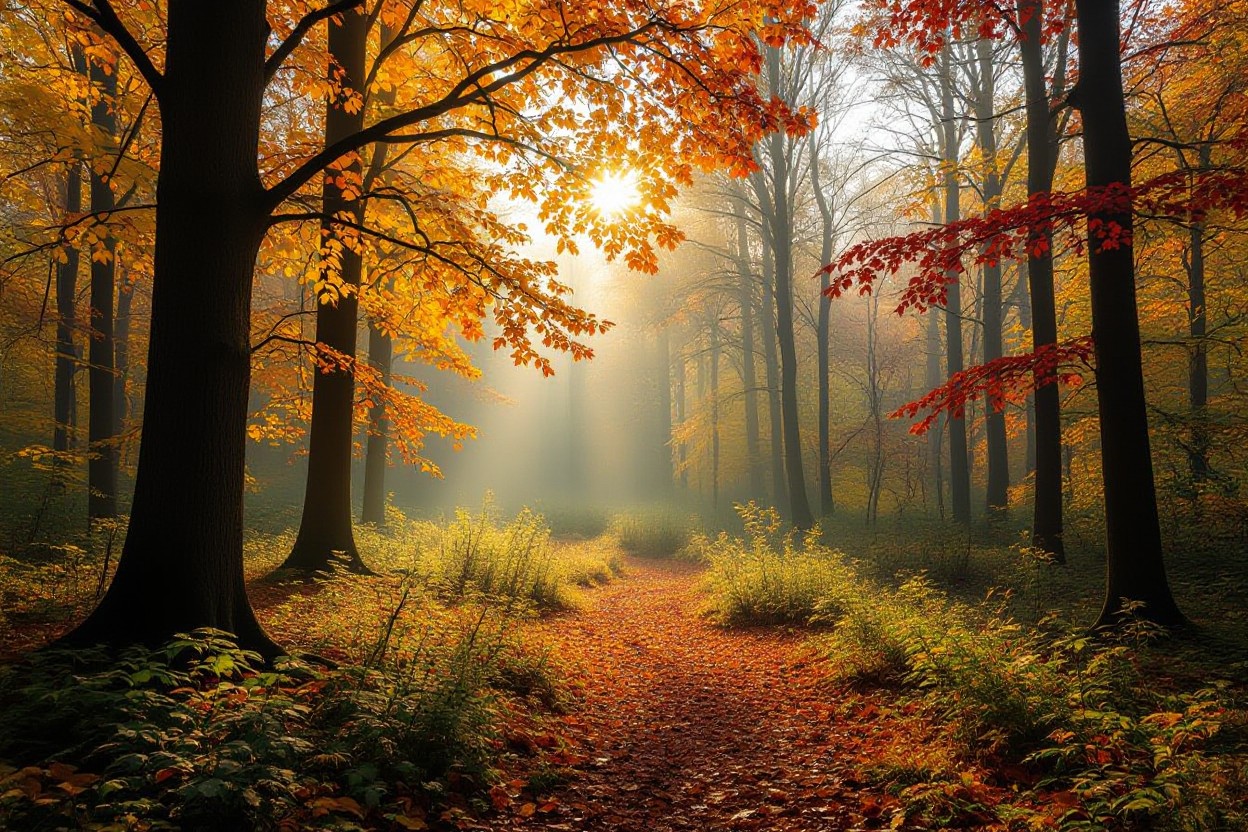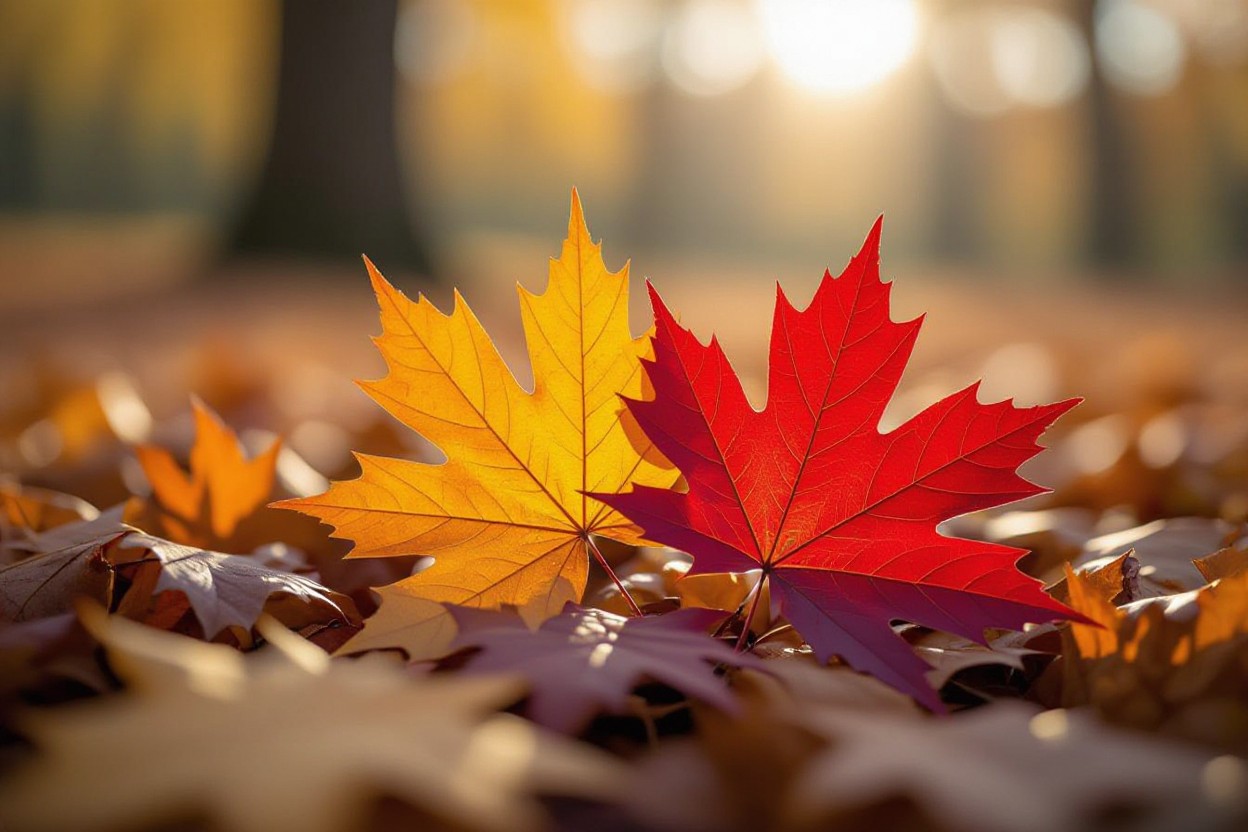This phenomenon of leaves changing color in fall is a fascinating intersection of biology and chemistry that I find endlessly intriguing. As the days shorten and temperatures drop, your trees begin a complex process of shutting down photosynthesis. Chlorophyll, the green pigment, breaks down, revealing hidden pigments like carotenoids and anthocyanins, which paint the landscape in vibrant yellows, oranges, and reds. Understanding this transformation not only deepens your appreciation of autumn’s beauty but also highlights the delicate balance of life adapting to environmental changes, a reminder of nature’s relentless ingenuity and resilience.
The Science of Leaf Pigments
Understanding why leaves change color in fall requires peeling back the layers of nature’s palette, revealing the complex interplay of pigments within leaf cells. These pigments—principally chlorophyll, carotenoids, and anthocyanins—dictate the vibrant spectacle you see. As daylight shortens and temperatures dip, their concentrations shift dramatically, rewriting the leaf’s color narrative from lush green to fiery reds, yellows, and oranges. This transformation is not just aesthetic but a biochemical response rooted deeply in the leaf’s life cycle and environment.
Chlorophyll: The Dominant Green
Chlorophyll serves as the leaf’s primary agent of photosynthesis, absorbing sunlight and converting it into energy. Its molecular structure strongly absorbs blue and red wavelengths but reflects green, making it the dominant pigment throughout spring and summer. By autumn, chlorophyll production dwindles as the tree redirects nutrients back into its trunk and roots. This decline allows other pigments, previously masked by chlorophyll’s overwhelming presence, to emerge and paint the visual transition so characteristic of the season.
Carotenoids and Anthocyanins: The Seasonal Shift
As chlorophyll fades, carotenoids reveal their enduring yellow and orange hues, having persisted in the leaf all year round but overshadowed by green. Anthocyanins, however, arise freshly in autumn; their deep reds and purples develop as sugars accumulate in leaf cells, reacting with sunlight and temperatures. These pigments not only contribute to the vibrant autumnal display but also serve protective roles, filtering harmful light and deterring herbivores precisely when the tree is most vulnerable.
The production of anthocyanins correlates strongly with light exposure and temperature variations, especially in species like the red maple or sugar maple. During bright, cool autumn days, sugar concentration in leaves spikes, facilitating anthocyanin synthesis. This pigment’s antioxidant properties protect leaf tissues from photo-oxidative damage, extending nutrient recovery before leaf fall. Meanwhile, carotenoids such as beta-carotene and lutein enhance photosynthetic efficiency throughout the year and, during autumn, provide a foundation for the warm tones we associate with fall, underscoring the intricate balance between survival and seasonal aesthetics.

Environmental Triggers for Color Change
Environmental factors act as catalysts in the fall leaf color transformation. The interplay between temperature fluctuations, shifting daylight hours, and moisture availability creates the backdrop for pigment changes in leaves. These variables influence not only the intensity but also the timing of autumn hues, revealing the dynamic nature of the ecosystem in response to seasonal transitions.
Temperature and Daylight: The Two Key Factors
Temperature and daylight serve as the primary environmental cues for autumnal color shifts. Cooler temperatures slow chlorophyll production, allowing carotenoids and anthocyanins to emerge more vividly. Meanwhile, shortening daylight signals trees to reduce chlorophyll synthesis altogether. Together, these variables trigger a cascade of biochemical processes inside leaves:
| Temperature and Daylight Effects | |
|---|---|
| Short Days | Signal preparation for dormancy by reducing chlorophyll |
| Cool Nights | Enhance red anthocyanin production, deepening red and purple shades |
| Warm Sunny Days | Favor carotenoid visibility with maintained pigment stability |
| Early Frosts | Can limit pigment development, dulling colors |
The balance of these factors results in the spectacular and variable palette of fall foliage you see in different regions.
Water Supply and Soil Conditions: Their Impact on Coloration
Soil moisture and water availability profoundly influence leaf pigment expression. Drought conditions often intensify red anthocyanin production as trees protect themselves from oxidative stress, while excessive water can dilute pigments and shorten the display duration. Furthermore, nutrient-poor soils might limit pigment synthesis, resulting in less vibrant colors. Thus, the hydration and composition of your local soil interplay with seasonal weather to shape the fall colors’ brilliance and longevity.
Additional research highlights that trees enduring moderate drought stress tend to produce deeper reds due to increased sugar concentration in leaves, which fuels anthocyanin synthesis. Conversely, in regions with abundant rainfall and rich soils, the dominance of yellow carotenoids often overshadows reds. This complex response demonstrates how subtle variations in environmental stress and soil chemistry directly affect the vividness and timing of your autumn spectacle.
The Role of Tree Species in Color Variation
Different tree species display distinct autumn hues due to variations in their pigment compositions and biochemical pathways. For example, maples often turn brilliant reds because they produce high levels of anthocyanins, while oaks lean toward deep browns and russets due to tannin accumulation. These differences arise from species-specific metabolic processes and adaptive responses to environmental triggers, resulting in a stunning mosaic of colors that define the autumn landscape.
Deciduous vs. Coniferous Trees: A Comparative Analysis
| Deciduous Trees | Coniferous Trees |
|---|---|
|
Shed leaves annually, displaying vibrant reds, yellows, and oranges |
Retain needles year-round, often staying green |
Genetic Factors: Why Some Trees Are More Vibrant
Genetic variation controls pigment production intensity and timing, explaining why certain trees burst into vivid reds or maintain duller hues. Genes regulate anthocyanin synthesis enzymes, influencing red saturation, while others govern carotenoid concentrations responsible for yellows. Environmental response genes also modulate color changes based on sunlight and temperature sensitivity. Genetic predisposition plays a dominant role in autumn coloration patterns.
- Leaves change color due to gene-regulated pigment shifts
- Anthocyanin production varies genetically, affecting reds
- Carotenoid levels influence yellow and orange shades
- Environmental gene interaction fine-tunes pigment expression
Thou, understanding the genetic blueprint helps predict and appreciate fall’s color diversity.
Digging deeper, genetic diversity within a species produces individual trees with varying displays of autumn color. For instance, red maple trees in different regions can show different red intensities, illustrating localized genetic adaptations. Some genotypes favor early anthocyanin synthesis triggered by cooler nights and abundant sugars, enhancing red brilliance. Others prioritize carotenoid retention, offering golden hues. Such intra-species variability showcases evolution’s nuanced control over pigment biosynthesis pathways.
- Localized genetics influence color vibrancy within species
- Anthocyanin gene regulation varies by genotype and environment
- Carotenoid retention differs among individual trees
- Evolutionary adaptations optimize fall coloration for survival
Thou, the genetic complexity behind these changes fuels the spectacular variation you witness each autumn.

The Cultural Significance of Autumn Colors
Autumn leaves offer more than a visual spectacle; they weave into the fabric of cultural expression around the globe. From the Japanese tradition of momijigari, the custom of leaf hunting, to the Native American harvest festivals, the vibrant hues symbolize change, reflection, and renewal. Such colors have inspired poets and painters alike, framing the season’s transient beauty as a metaphor for life’s cycles. The spectrum of reds, oranges, and yellows resonates deeply in art, literature, and communal rituals, signaling not just environmental transition but also a shared human experience of transformation.
Folklore and Festivals: The Historical Connection
Historically, many cultures attributed supernatural significance to the changing leaves, associating the colors with spirits or divine messages. In European folklore, for example, fiery red leaves were often seen as the breath of fallen warriors or the marks of autumnal deities. Festivals such as the German Erntedankfest or the American Thanksgiving celebrate the season’s bounty, with leaf colors serving as vivid reminders of the earth’s generosity and impending rest. These traditions link human gratitude and seasonal cycles directly through the kaleidoscope of leaf pigments.
The Impact on Tourism and Economy: Why Leaf Peeping Matters
The surge in tourism during fall, especially in regions like New England and the Canadian Rockies, underlines the economic importance of leaf color changes. Leaf peeping—traveling specifically to view autumn foliage—can inject millions into local economies, supporting hotels, restaurants, and artisan crafts. States like Vermont and Colorado report that up to 40% of their annual tourism revenue stems from this seasonal attraction, underscoring how these natural phenomena translate into significant financial incentives for conservation and public engagement.
Beyond direct spending, the autumn tourism industry fosters community development and environmental awareness. Businesses tailor services to optimize visitor experience during peak foliage weeks, often collaborating with conservation groups to promote sustainable travel. This synergy not only enhances economic resilience but also helps maintain the landscapes that captivate so many. Consequently, leaf peeping goes beyond passive enjoyment; it actively shapes the stewardship and economy of regions invested in preserving autumn’s beauty for future generations.

The Ecological Importance of Leaf Color Change
The transformation of leaf colors is not just an aesthetic event but a vital ecological process. As chlorophyll degrades, trees reabsorb valuable nutrients like nitrogen and phosphorus into their roots, enhancing survival through winter. The brilliant reds and oranges come from anthocyanins, compounds that protect leaves from light damage and aid nutrient recovery. This process reduces leaf litter toxicity, enriching the soil upon leaf fall, and influences forest floor dynamics by altering microbial activity and nutrient cycling. Such changes underscore a finely tuned ecological strategy beyond mere beauty.
Photosynthesis and Energy Conservation: An Adaptive Strategy
In autumn, declining daylight and temperatures inhibit efficient photosynthesis, compelling trees to minimize energy expenditure. Breaking down chlorophyll allows trees to reclaim nutrients and funnel them into storage tissues, preparing for dormancy. Anthocyanins serve as natural sunscreens, shielding the delicate recovery process from photo-oxidative stress. This adaptive balance between conserving energy and managing environmental stress demonstrates nature’s elegant insulation tactics against the impending winter.
Implications for Ecosystems: Interactions with Animals and Other Plants
Leaf color change ripples through ecosystems by signaling seasonal shifts that influence animal behavior. For instance, certain herbivores use color cues to gauge leaf palatability, while some insects synchronize life cycles with leaf senescence. Fallen leaves become habitat and nutrient sources for decomposers, indirectly supporting food webs. Additionally, the timing and intensity of color changes can affect neighboring plants by modifying light penetration and microclimates. This interplay highlights the interconnectedness of autumnal processes with broader ecological networks.
Diving deeper, autumnal leaf color shifts serve as ecological signals that orchestrate behavior across multiple trophic levels. The bright reds of maples can deter pests like aphids by indicating high levels of protective compounds, thereby affecting insect population dynamics. Simultaneously, ground-dwelling fauna utilize the thicker leaf litter for shelter during colder months, creating habitats that sustain species diversity. These processes influence nutrient turnover rates, impacting plant regeneration and soil chemistry. Such multifaceted interactions illustrate how leaf pigments function as both biological communication tools and environmental modifiers within forest ecosystems.
Summing up
As a reminder, the vibrant transformation of leaves in fall is a splendid display of nature’s adaptive strategy. I see how the shift is driven by changes in daylight and temperature, prompting leaves to cease chlorophyll production and unveil the hidden pigments within. You can appreciate this annual spectacle not merely as aesthetic delight but as a profound example of life’s intricate biochemical processes responding to environmental cues. Understanding this encourages us to cherish the delicate interplay between living organisms and their surroundings that crafts autumn’s brilliant tapestry.




Leave a comment